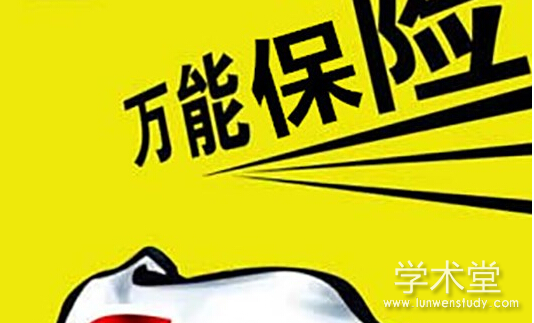摘要
在万能险监管环境不断严格的情况下,部分网络平台类的保险公司面临着保费规模扩张和公司资本增值的双重压力,我国保险市场上,万能险规模增长速度已经呈现放缓趋势,在 2017 年万能险发展速度出现了拐点现象。笔者以万能险出现拐点为研究背景,运用了文献综述法、规范研究法和对比分析法等,阐述了我国万能险从2002 年至今日的发展历程,介绍了万能险的发展现状,以及指出现在我国万能险已出现了异化现象。
在 2012 年至 2016 年的 4 年时间里,我国万能险是处于高速发展时期的,保险企业频繁举牌和保险资金的激进利用,给保险公司带来高投资收益同时又引起了万能险的异化。所以本文就在第三章主要分析了我国万能险异化的原因及万能险异化带来的问题,原因主要有我国监管导向引起的异化,股东贪大求快心态引起的异化以及公司管理者经营惯性引起的异化。我国万能险异化带来的问题有:资产负债不匹配带来的一系类问题,弱化了寿险的保障功能以及退保现象严重等。
最后针对我国万能险异化提出针对性建议和对策:第一,加强主动性资产负债管理模式。第二,完善万能险产品结构落实保障功能。三是,加大对销售人员的管理力度减少退保率。四是,完善偿付能力监管制度。
关键词:万能险;万能险异化;低保障;高风险;费率市场化。
Abstract
Under the increasingly stringent supervision environment of universal insurance. Someinsurance companies in the online platform face the dual pressure of expansion of premiumscale and capital appreciation of the company. In China's insurance market. The growth rateof universal insurance has shown a slowing trend in 2017. There has been a turning point inthe pace of development of universal insurance. Taking the inflection point of universalinsurance as the research background. The author used the literature review method.
Normative research method and comparative analysis method to elaborate the developmenthistory of China's universal insurance from 2002 to the present day. Introduced thedevelopment status of universal insurance and pointed out that China's universal insurance hasappeared dissimilation.

In the four years from 2012 to 2016. China's universal insurance is in a period of rapiddevelopment. Insurance companies frequently use brand licensing and aggressive use ofinsurance funds. Bringing high investment income to insurance companies and at the sametime causing the alienation of universal insurance . Therefore, in the third chapter. This papermainly analyzes the causes of the dissimilation of universal energy in China and the problemsbrought by the dissimilation of universal insurance. The main reasons are the alienationcaused by China's regulatory guidance. The alienation caused by the greed for theshareholders and the inertia of the company managers. Alienation caused. The problemsbrought about by the dissimilation of universal energy in China are: a series of problemscaused by the mismatch of assets and liabilities.which weakens the protection function of lifeinsurance and the seriousness of surrender.
Finally. Hina's universal insurance. First.It strengthens the proactive asset and liabilitymanagement model. Second. Improve the structure of universal insurance products toimplement the safeguard function. Third. increase the management of sales personnel toreduce the rate of surrender. The fourth is to improve the solvency supervision system.
Key words: Universal insurance; Universal insurance alienation; Lowsecurity; Highrisk; Rate liberalization
目录
第 1 章 绪论
1.1 选题背景.
1.2 文献综述.
1.3 研究内容.
1.4 研究思路和方法
1.5 创新与不足
第 2 章 我国万能险发展历程及异化
2.1 我国万能险发展历程及现状 .
2.2 我国万能险异化的表现
2.1.1 万能险负债成本高造成利差损
2.1.2 万能险费用率高造成费差损
2.1.3 重理财轻保障.
第 3 章 我国万能险异化的原因及带来的问题
3.1 我国万能险异化的原因
3.1.1 监管导向引起的异化
3.1.2 股东的贪大求快心态引起的异化 .
3.1.3 经营管理者的经营惯性引起的异化 .
3.2 万能险异化带来的问题
3.2.1 资产负债不匹配带来的问题
3.2.2 弱化了寿险的保障功能
3.2.3 误导销售导致的退保现象严重
3.2.4 弱化了保险公司的偿付能力
第 4 章 对策与建议 .
4.1 加强主动型资产负债管理模式 .
4.2 完善万能险产品结构落实保障功能.
4.3 加大对销售人员的管理力度减少退保率
4.4 完善偿付能力监管制度
结论.
参考文献
保险公司利率大幅下降与寿险的费率市场化有很大的关系,但从目前万能险的产品结构状况来看,在寿险产品中传统人身保险产品占份额比较小,所以它对人寿保险业整体保费增长变化影响是非常小的。...
保险公司频繁举报事件也是这一点的有力例证。一些保险公司已将资金转向股票市场,以抵消销售万能保险的高昂成本。 许多保险公司在股票市场持有许可证或准举牌,并提高股票价格以获得超额收益。...
目前我国寿险行业中有三种比较受欢迎的资产负债匹配管理模式:第一种是被动的负债驱动资产模式。第二种是资产驱动负债模式。第三种是主动型资产负债匹配管理模式,它是指通过在资产端和负债端进行积极的互动管理来达到匹配的效果。...
我国保险公司在迫不及待地改善自己产品对消费者的吸引力,甚至不根据保险公司自身的经营状况就采取高的结算利率来结算,这样做的目的就是为了增加保费。...